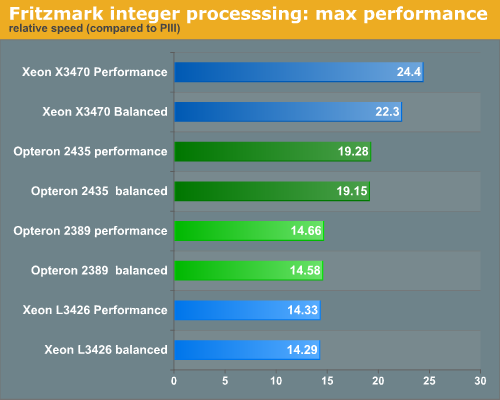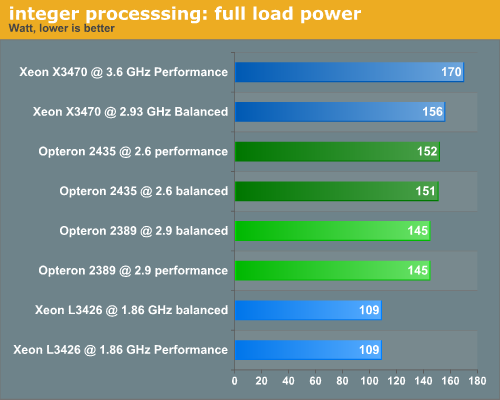Dynamic Power Management: A Quantitative Approach
by Johan De Gelas on January 18, 2010 2:00 AM EST- Posted in
- IT Computing
More Performance Please!
Now let's push the processor cores to their best performance.

When the going gets tough, the tough get going. The L3426 has a very tight TDP limit with no headroom for any extra Turbo Boost action. The X3470 has a TDP limit with a large margin, and as a result it's still capable of boosting the clock speed a bit higher (3.066GHz) when running eight threads.
At the same time, this graph shows how superior the integer engine of the "Nehalem" based cores is over AMD. A 1.9GHz quad-core offers about the same performance as a 2.9GHz quad-core. It also shows that for - well multi-threaded - integer applications, AMD's six-core was a decent countermeasure.

Turbo Boost delivers better performance, but comes with a power price. The influence is not really shocking at the system level - 9% higher power - but it is significant if you only look at the processor power level. We are still working on our methodology to measure power at the component level, but looking at the idle power and the spec sheets we can estimate CPU power rather well. Looking at the CPU level, Turbo Boost probably needs from 15% to 17% more power to the CPU VRMs.










35 Comments
View All Comments
JohanAnandtech - Monday, January 18, 2010 - link
In which utility do you set/manage the frequency of a separate core?n0nsense - Monday, January 18, 2010 - link
Gnome panel applets. CPU frequency monitor I guess it uses cpufreq. Each instance monitors core. So i have 4 of them visible all the time. If you have enabled CPU Frequency scaling (kernel) than you can select the governor (performance, on demand, conservative etc) or a static frequency. I can do it for each core. And it displays what i have set.Of course processor should support frequency scaling.(power now and speed step).
Most mainstream distributions (Ubuntu, Sabayon, Fedora) will use onedemand governor by default when processor with frequency scaling available. No user intervention required.
jordanclock - Monday, January 18, 2010 - link
I really think you're mistaken. Core 2 CPUs don't have any mechanism to allow per-core frequencies. There is one FSB clock and one multiplier. There is no way to set CPU0 to a different frequency than CPU1 (or for quad core, CPU2 and CPU3) because the variables that control the clock speed are chip wide.VJ - Tuesday, January 19, 2010 - link
These people seem to be convinced of per-core Speedstep:https://bugs.launchpad.net/ubuntu/+source/linux-so...">https://bugs.launchpad.net/ubuntu/+source/linux-so...
Maybe someone can ask David Tomaschik for the Intel documentation he refers to?
n0nsense - Monday, January 18, 2010 - link
I heard it in past, but i still tend to believe my eyes :)while writing this reply, i saw any possible combination. My Q9300 has 2 states 2.0GHz and
2.5GHz. It's not a server CPU. Have no reason to mislead you
VJ - Tuesday, January 19, 2010 - link
If there's only two states, then it's possible that one core is in the C2 state while the other is in its C0 state.The core in state C2 may be shown to be operating at 2Ghz (its lowest frequency) while it's really off. The OS may simply be reporting the lowest possible frequency while the core is really not receiving a clock signal.
So in general, if one core is showing its lowest frequency it may be off which still allows the other core to operate (at a different frequency).
It would be very strange if both cores are operating greater than their lowest and less than their highest frequencies at different frequencies.
From a different angle: Has anybody ever seen /proc/cpuinfo report a frequency less than the CPU/Core's lowest active frequency or even zero? Probably not.
n0nsense - Tuesday, January 19, 2010 - link
Nice theory :)But in this case, I see that each core doing something. htop shows that each core somewhere in 15% usage. So the only options left, are
1. Each core frequency can be controlled independently on C2D and C2Q (May be i3 i5 i7 too)
2. The OS is completely unaware of whats going on :) (which is less possible)
mino - Thursday, January 21, 2010 - link
"The OS is completely unaware of whats going on" is the right answer.:)
BTW, only x86 CPU's able to change freq per core are >=K10 for AMD and >=Nehalem for Intel.
VJ - Tuesday, January 19, 2010 - link
Not to defeat your argument/observations, rather for completeness' sake:It's also possible that the differences are due to the reading of the attributes. If the attributes are read in succession, then it's possible that the differences are due to the time of reading the attributes, while at any given instant, notwithstanding the allowable subtle differences in frequency described in this article, all cores are operating at the same frequency.
There's a lot of time at the bottom.
JanR - Tuesday, January 19, 2010 - link
Hi,I completely agree to this:
"It's also possible that the differences are due to the reading of the attributes."
The point is that desktop usage together with ondemand governor leads to a lot of fast frequency changes. Therefore, this is not a good scenario to decide on "per core" vs "per CPU". We did a lot of testing the following way:
Put load on all cores using "taskset" (this avoids C-states). Switch to "userspace" governor and then set frequencies of individual cores differently. You have one control per core but the actual hardware decides what really happens - you can check this in /proc/cpuinfo or using a tool such as "mhz" from lmbench as load generator (this one calculates actual frequency based on CPI and time, it allows also measurement of turbo frequencies).
Trying around, the results are:
AMD K8: One clock domain, maximum of the requested frequencies is taken
Intel Core2 Duo: Same as K8
AMD K10: Individual clock domains, you can clock each core individually
Intel Core 2 Quad: TWO clock domains! These CPUs are two dual core dies glued together so each die has its one multiplicator. Therefore, the cores of each die get the maximum of the requested frequencies but you can clock the two dies independendly.
Intel Nehalem: One clock domain, maximum of requests of all cores that are not in C-state! If you set one core to, e.g., 2.66 GHz and all other to 1.6, all cores clock at 1.6 as long as the core set to 2.66 is not used, they all switch to 2.66 if you put load on that core.
So far to our findings. "cat /proc/cpuinfo" or some funny tools are useless if you do not control the environment (userspace, manual settings). If you then enable ondemand, the system switches fast between different states and looking at it is just a snapshot, maybe taken in the middle of a transition.
Greetings,
Jan